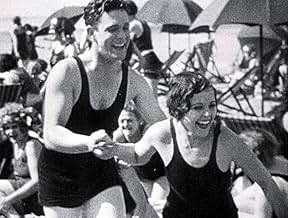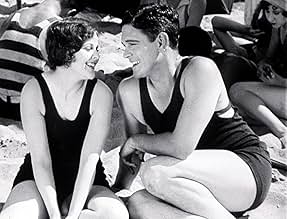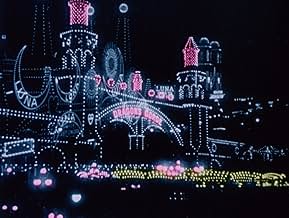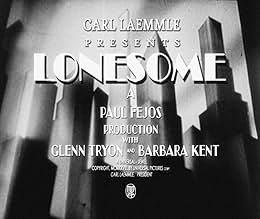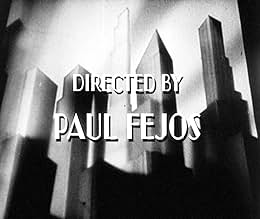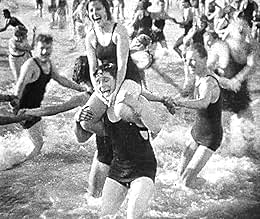VALUTAZIONE IMDb
7,7/10
2821
LA TUA VALUTAZIONE
Aggiungi una trama nella tua linguaTwo lonely people in the big city meet and enjoy the thrills of an amusement park, only to lose each other in the crowd after spending a great day together. Will they ever see each other aga... Leggi tuttoTwo lonely people in the big city meet and enjoy the thrills of an amusement park, only to lose each other in the crowd after spending a great day together. Will they ever see each other again?Two lonely people in the big city meet and enjoy the thrills of an amusement park, only to lose each other in the crowd after spending a great day together. Will they ever see each other again?
- Regia
- Sceneggiatura
- Star
- Premi
- 1 vittoria in totale
Gusztáv Pártos
- Romantic Gentleman
- (as Gustav Partos)
Henry Armetta
- Ferris wheel guy
- (non citato nei titoli originali)
Edgar Dearing
- Cop
- (non citato nei titoli originali)
Louise Emmons
- Telephone Caller
- (non citato nei titoli originali)
Fred Esmelton
- Swami
- (non citato nei titoli originali)
Jack Raymond
- Barker
- (non citato nei titoli originali)
Churchill Ross
- Telephone Caller
- (non citato nei titoli originali)
Recensioni in evidenza
... and I could say the same thing about Fejos' "Broadway", made a year later. Fejos recounts the tale of two lonely New Yorkers, Jim (Glen Tryon) and Mary (Barbara Kent), who find love and each other during a half day holiday at the beach and Coney Island. You first see the workday from Jim and Mary's perspective as they are ruled first by the tyranny of the alarm clock and then the tedium of the workday as you see a clock overlaying the image of each at work. Jim is a low-level machine operator, and Mary is a telephone operator. Then there are "the crowds". Jim and Mary are crowded at breakfast, at a diner filled with patrons, crowded on the subway, crowded at work, and crowded at the beach and amusement park. Yet both of them are completely alone in the world, which, especially in the attractive Miss Kent's case, seems somewhat inconceivable.
This late era silent has a dearth of title cards, which does not subtract from the film's enjoyment. In fact, what does subtract just a little are the short dialogue scenes that just don't make sense. One scene is Jim and Mary on the beach suddenly in the dark AND in color, with the crowd removed. Nothing they say shines any light on their situation or feelings at all. Another one is in a courtroom where Jim has been detained for being unruly. He gives a speech like a Bolshevik basically shaming the judge and ... the judge lets him go???? This social awareness seems very strange stuff coming from Jim who, up to that point, has seemed to be a very uncomplicated fellow. Very strange, but typical of talking scenes inserted into silent films at the dawn of sound.
What is extra special about this film is to see the lives of working class people in 1928. Notice that the workday that Jim and Mary are going through is a Saturday, and this was the norm back then and until some time after WWII. People would normally work half a day on Saturday and have only Sunday in its entirety as a day off. Catch this film if you can, even if you are not a huge silent film buff.
This late era silent has a dearth of title cards, which does not subtract from the film's enjoyment. In fact, what does subtract just a little are the short dialogue scenes that just don't make sense. One scene is Jim and Mary on the beach suddenly in the dark AND in color, with the crowd removed. Nothing they say shines any light on their situation or feelings at all. Another one is in a courtroom where Jim has been detained for being unruly. He gives a speech like a Bolshevik basically shaming the judge and ... the judge lets him go???? This social awareness seems very strange stuff coming from Jim who, up to that point, has seemed to be a very uncomplicated fellow. Very strange, but typical of talking scenes inserted into silent films at the dawn of sound.
What is extra special about this film is to see the lives of working class people in 1928. Notice that the workday that Jim and Mary are going through is a Saturday, and this was the norm back then and until some time after WWII. People would normally work half a day on Saturday and have only Sunday in its entirety as a day off. Catch this film if you can, even if you are not a huge silent film buff.
If only this remarkable movie hadn't had the misfortune to be released just when the enthusiasm for sound was sweeping all before it, it would probably have been more appreciated at the time and remembered today as one of the all-time classics. As an expression of the isolation of city life, it builds up an atmosphere of desperation, in spite of its romance with a happy ending. The scene where the boy searches frantically for the girl throughout crowded Coney Island, buffeted this way and that by the uncaring throngs, turned away by the indifferent faces of the amusement park workers, has few equals for anguish. Also unforgettable is the montage that cuts from one to the other of the lovers (who have not yet met) while they are at work, the one at a factory, the other at a telephone switchboard; the motions of the hands and the machines build to a frantic, overwhelming pace.
Unfortunately, before the movie was released it was sadly mangled by the insertion of several sound sequences, which stop the continuity dead with their absolute stasis, and feature dialogue so thunderously inane you have to suspect it was written by the sound technician. Nonetheless, "Lonesome" remains one of the most sophisticated examples of the silent movie, an art form that was killed by sound almost as soon as it had reached maturity.
Unfortunately, before the movie was released it was sadly mangled by the insertion of several sound sequences, which stop the continuity dead with their absolute stasis, and feature dialogue so thunderously inane you have to suspect it was written by the sound technician. Nonetheless, "Lonesome" remains one of the most sophisticated examples of the silent movie, an art form that was killed by sound almost as soon as it had reached maturity.
8sb88
It's a shame Lonesome hasn't been seen more widely by modern audiences. The limited acclaim it's received is well deserved.
Lonesome is very simple. It's no more than a little romantic movie of two people who fall in love and then appear to lose each other. But the whole thing is told expertly well. The camera moves about freely in many unique and interesting ways. Visually alone, it's quite the spectacle. It also helps that the two in the lead roles are enjoyable.
Glenn Tyron is good enough in his lead role, but his romantic interest, played by Barbara Kent, is the real star. She is fun and playful when needed, but her soulful eyes convey more pain then most people ever could with their voices. Her charisma is evident from shot one.
The only downside to the film is the inclusion of a few sound scenes. Clearly done just to cash in on the new craze, it actually only serves to grind the story to a halt. It forces the movie to become stationary, and the dialogue itself is pretty inane.
I cannot recommend the film strongly enough, though. It's as enjoyable of a romance as you'll ever see. There's nothing too complicated here: just two people falling in love, and it's a joy to see.
Lonesome is very simple. It's no more than a little romantic movie of two people who fall in love and then appear to lose each other. But the whole thing is told expertly well. The camera moves about freely in many unique and interesting ways. Visually alone, it's quite the spectacle. It also helps that the two in the lead roles are enjoyable.
Glenn Tyron is good enough in his lead role, but his romantic interest, played by Barbara Kent, is the real star. She is fun and playful when needed, but her soulful eyes convey more pain then most people ever could with their voices. Her charisma is evident from shot one.
The only downside to the film is the inclusion of a few sound scenes. Clearly done just to cash in on the new craze, it actually only serves to grind the story to a halt. It forces the movie to become stationary, and the dialogue itself is pretty inane.
I cannot recommend the film strongly enough, though. It's as enjoyable of a romance as you'll ever see. There's nothing too complicated here: just two people falling in love, and it's a joy to see.
Silent movies had a unique appeal to viewers in early cinema in that they forced the public to use their imaginations to fill in the gaps when the characters were speaking to one another. Silents didn't require extensive inter titles to get the jest of the actors' conversations. Consequently, the actors became larger than life because they weren't dragged down by imperfections in tonality and delivery most mortals possess.
So when the first 'talkies' starting dribbling out of Hollywood after October 1927's "The Jazz Singer" was released, the voices emitting from the screen must have been jarring to those not used to hearing their acting idols speak. One of the first feature films after "The Jazz Singer" to contain a bit of audible dialogue was June 1928's "Lonesome." The film was initially released as a silent, then in September edited with three sequences of actual talking. The first talking sequence is 30 minutes into the film when Mary (Barbara Kent) and Jim (Glenn Tryon), meeting for the first time at Coney Island's amusement park, are sitting on the beach saying how lucky they are meeting each other. As one modern-day critic describes it, "They suddenly seemed very childlike and embarrassing compared to their 'silent selves,' perhaps even silly and sappy. They seemed flawed and human once I heard their voices. It was an interesting way for me to think about silence versus sound in cinema, as this film allows one to essentially to see both types in the same film."
Film critic Andrew Saris claimed "Lonesome" was "a tender love story in its silent passages, but crude, clumsy and tediously tongue-tied in its talkie passages." There is one sequence in the dialogue portion that justifies the talkie addition. Jim gets hauled into the police station after a cop accused him of roughing him up after he tried break through the crowd to get to Mary, who had fainted. The police commander, debating whether to charge Jim, at first plays hardball. But when Jim pleads his case, you can hear the change of tone of the adjudicating official when he decides to let him go. An inter title could never convey such a friendlier timbre of the officer.
The appeal of "Lonesome" is that the Paul Fejos-directed movie addresses a universal problem focused on singles living a solitary life in the big city. Jim, a keypunch machine operator at a city factory, and Mary, a telephone operator, work long hours. Their opportunities to meet the opposite sex are few. Fejos, a former medic with the Austrian Army on the front lines of World War One front lines whose love for theater transformed into directing film, used a bag of special effects tricks early on to cleverly portray the pair, using double exposures to show their routine day. The two do link up at the park and have a magical time staring into each other's eyes. Fejos colors his celluloid with hand-tinted and stencil-color segments to illustrate their romantic state.
Once "Lonesome" was released in June, Universal Studio executives felt adding the talking sequences to the movie would add some pizzazz. The studio borrowed a Movietone News sound recording truck from Fox Pictures, owners of the audio system, on the pretext it was conducting sound tests when actually it was filming the three audible sequences. Fejos wasn't involved in those shoots, which didn't dampen critics' enthusiasm for the film, citing it as the highlight of his career. "Lonesome" was a great success for Universal, partly because of the revolutionary insertion of those "talking" segments.
So when the first 'talkies' starting dribbling out of Hollywood after October 1927's "The Jazz Singer" was released, the voices emitting from the screen must have been jarring to those not used to hearing their acting idols speak. One of the first feature films after "The Jazz Singer" to contain a bit of audible dialogue was June 1928's "Lonesome." The film was initially released as a silent, then in September edited with three sequences of actual talking. The first talking sequence is 30 minutes into the film when Mary (Barbara Kent) and Jim (Glenn Tryon), meeting for the first time at Coney Island's amusement park, are sitting on the beach saying how lucky they are meeting each other. As one modern-day critic describes it, "They suddenly seemed very childlike and embarrassing compared to their 'silent selves,' perhaps even silly and sappy. They seemed flawed and human once I heard their voices. It was an interesting way for me to think about silence versus sound in cinema, as this film allows one to essentially to see both types in the same film."
Film critic Andrew Saris claimed "Lonesome" was "a tender love story in its silent passages, but crude, clumsy and tediously tongue-tied in its talkie passages." There is one sequence in the dialogue portion that justifies the talkie addition. Jim gets hauled into the police station after a cop accused him of roughing him up after he tried break through the crowd to get to Mary, who had fainted. The police commander, debating whether to charge Jim, at first plays hardball. But when Jim pleads his case, you can hear the change of tone of the adjudicating official when he decides to let him go. An inter title could never convey such a friendlier timbre of the officer.
The appeal of "Lonesome" is that the Paul Fejos-directed movie addresses a universal problem focused on singles living a solitary life in the big city. Jim, a keypunch machine operator at a city factory, and Mary, a telephone operator, work long hours. Their opportunities to meet the opposite sex are few. Fejos, a former medic with the Austrian Army on the front lines of World War One front lines whose love for theater transformed into directing film, used a bag of special effects tricks early on to cleverly portray the pair, using double exposures to show their routine day. The two do link up at the park and have a magical time staring into each other's eyes. Fejos colors his celluloid with hand-tinted and stencil-color segments to illustrate their romantic state.
Once "Lonesome" was released in June, Universal Studio executives felt adding the talking sequences to the movie would add some pizzazz. The studio borrowed a Movietone News sound recording truck from Fox Pictures, owners of the audio system, on the pretext it was conducting sound tests when actually it was filming the three audible sequences. Fejos wasn't involved in those shoots, which didn't dampen critics' enthusiasm for the film, citing it as the highlight of his career. "Lonesome" was a great success for Universal, partly because of the revolutionary insertion of those "talking" segments.
Lonesome is like the much more charming, if slightly less ambitious (and at the very end a bit too cute) cousin of Sunrise. It's appeal is in its simplicity, but where Sunrise was about a couple breaking apart and coming back together, this is much more streamlined and less tragic (though it does go for some tragic beats in the last twenty minutes of its slim 70-minute run-time): boy is lonely, girl is lonely, both work working-class jobs (factory/phone operator, what else in New York city in 1928?), they both decide separately after their (so-called!) friends go off on their own adventures to go to the beach and amusement park - is it Coney Island? I can't imagine it being anywhere else - and boy and girl meet as the boy tries to show off doing games. And that's it, that's the movie, and why it stands out (and got a sort-of restoration and Criterion treatment) is its presentation by its director.
I don't know much about Pal (Paul) Fejos except that he directed silent films and somewhat into the 1930's, and then sort of faded away into obscurity. It's a shame since a film like Lonesome shows his talents clearly: he has a keen sense of editing and that way that silent filmmakers sometimes had to super-impose images (perhaps a chip off the Abel Gance block perhaps, but not as ambitious), in particular when he's setting up the hustle/bustle of the city and then later in the film when things get more harrowing with the characters. That is to say when, inevitably, the main conflict is that they are separated in that great sea of people that makes up a massive crowd in a city (where, as the man, Jim, notes at one point, is so strange that you're surrounded by so many but still feel so alone).
The charm in the film comes in how the couple on screen - Barbara Kent and Glenn Tryon - are together; they're kind of like if you had one of those romantic "leads" in those really early Marx brothers movies, only they don't sing and the man is funny in that amusing- lightly- sarcastic way (i.e. bragging about his "six acres on Wall street" at first, which we and the girl knows isn't true, but it's fun to play along). Actually, speaking of that, this is an experimental film at heart for a number of reasons. It appears at first to be a silent film, and for 90% of it it surely is, and is shot like one with that film speed we associate with silent cinema on the whole (that kind of slightly-sped-up speed where its rhythm is distinctly of its cameras and era), and we know this because 10% of the film, more or less, is a *sound* film. No, really, we suddenly move from what is the obvious fluid camera style and wide shots of the crowds and intensity that comes with a camera that moves freely to what is clearly static shots in a studio so the actors are right under a microphone... and the acting is just as static.
That's not totally fair; this is considered, at least according to the trivia, one of the very first films to ever incorporate sound. On that level it's certainly extraordinary and important, but the problem is that it becomes jarring with the rest of the film which is shot with such passion and excitement (it's also frankly weird to hear the actor's speaking voices, whereas before, like I do with a lot of silent movies, I can think of my own voices for the actors that do not sound so... stilted). One of the sound scenes is also one where I wasn't sure if a cop was being sarcastic or not; our man Jim has been taken away by the cops after a roller-coaster ride where Mary, the girl, fainted and had to be taken away but Jim got separated and got rough with a cop. For a moment it seems like he'll be put away, but Jim pours his heart out (with some, I'm sorry, cringe-inducing lines), and the cop's reaction is hard to read since it sounds totally "pfft yeah right"... but then they let him go. Very strange.
But these aren't major complaints for a film that has so much to offer outside of those things. This is a movie that's joy is in its purity, that it's about these two people and how they meet and suddenly all of the usual problems of their everyday lives - the work, the drudgery, the intensity of being around so many people getting on/off the subways or being in the traffic - can float away since they have one another. And there are some moments of experimentation that do work, mostly involving (also, again, a touch of daring with Fejos) color: there's tinted scenes here, which isn't unusual for a silent film, but here it's how the colors are used, over the amusement park scenes to illuminate the lights at night, the performers in the park, the vibrancy that the night off a beach in the city brings.
There are so many moments of rich filmmaking, so much hope that this couple is able to inspire in a short amount of time, and because of the simplicity we're able to invest ourselves into their bond as it gets closer (maybe a little *too* quick, one might want to argue, falling in love within a day), that one can almost forgive a cutesy ending. Almost.
I don't know much about Pal (Paul) Fejos except that he directed silent films and somewhat into the 1930's, and then sort of faded away into obscurity. It's a shame since a film like Lonesome shows his talents clearly: he has a keen sense of editing and that way that silent filmmakers sometimes had to super-impose images (perhaps a chip off the Abel Gance block perhaps, but not as ambitious), in particular when he's setting up the hustle/bustle of the city and then later in the film when things get more harrowing with the characters. That is to say when, inevitably, the main conflict is that they are separated in that great sea of people that makes up a massive crowd in a city (where, as the man, Jim, notes at one point, is so strange that you're surrounded by so many but still feel so alone).
The charm in the film comes in how the couple on screen - Barbara Kent and Glenn Tryon - are together; they're kind of like if you had one of those romantic "leads" in those really early Marx brothers movies, only they don't sing and the man is funny in that amusing- lightly- sarcastic way (i.e. bragging about his "six acres on Wall street" at first, which we and the girl knows isn't true, but it's fun to play along). Actually, speaking of that, this is an experimental film at heart for a number of reasons. It appears at first to be a silent film, and for 90% of it it surely is, and is shot like one with that film speed we associate with silent cinema on the whole (that kind of slightly-sped-up speed where its rhythm is distinctly of its cameras and era), and we know this because 10% of the film, more or less, is a *sound* film. No, really, we suddenly move from what is the obvious fluid camera style and wide shots of the crowds and intensity that comes with a camera that moves freely to what is clearly static shots in a studio so the actors are right under a microphone... and the acting is just as static.
That's not totally fair; this is considered, at least according to the trivia, one of the very first films to ever incorporate sound. On that level it's certainly extraordinary and important, but the problem is that it becomes jarring with the rest of the film which is shot with such passion and excitement (it's also frankly weird to hear the actor's speaking voices, whereas before, like I do with a lot of silent movies, I can think of my own voices for the actors that do not sound so... stilted). One of the sound scenes is also one where I wasn't sure if a cop was being sarcastic or not; our man Jim has been taken away by the cops after a roller-coaster ride where Mary, the girl, fainted and had to be taken away but Jim got separated and got rough with a cop. For a moment it seems like he'll be put away, but Jim pours his heart out (with some, I'm sorry, cringe-inducing lines), and the cop's reaction is hard to read since it sounds totally "pfft yeah right"... but then they let him go. Very strange.
But these aren't major complaints for a film that has so much to offer outside of those things. This is a movie that's joy is in its purity, that it's about these two people and how they meet and suddenly all of the usual problems of their everyday lives - the work, the drudgery, the intensity of being around so many people getting on/off the subways or being in the traffic - can float away since they have one another. And there are some moments of experimentation that do work, mostly involving (also, again, a touch of daring with Fejos) color: there's tinted scenes here, which isn't unusual for a silent film, but here it's how the colors are used, over the amusement park scenes to illuminate the lights at night, the performers in the park, the vibrancy that the night off a beach in the city brings.
There are so many moments of rich filmmaking, so much hope that this couple is able to inspire in a short amount of time, and because of the simplicity we're able to invest ourselves into their bond as it gets closer (maybe a little *too* quick, one might want to argue, falling in love within a day), that one can almost forgive a cutesy ending. Almost.
Lo sapevi?
- QuizIt was one of the first motion pictures to have sound and a couple of talking scenes. It was released in both silent and monaural versions. Some scenes in existing original prints of the film are colored with stencils.
- Versioni alternativeProduced in both sound and silent versions. The sound version was 6,785 feet in length, and the silent version was 6,193 feet.
- ConnessioniFeatured in Fejezetek a film történetéböl: Az amerikai film kezdetei (1989)
- Colonne sonoreAlways
(uncredited)
Written by Irving Berlin
[Played by dance orchestra at ballroom]
Sung by Nick Lucas
[on Brunswick recording played in last scene]
I più visti
Accedi per valutare e creare un elenco di titoli salvati per ottenere consigli personalizzati
- How long is Lonesome?Powered by Alexa
Dettagli
- Tempo di esecuzione
- 1h 9min(69 min)
- Mix di suoni
- Proporzioni
- 1.19:1
Contribuisci a questa pagina
Suggerisci una modifica o aggiungi i contenuti mancanti



